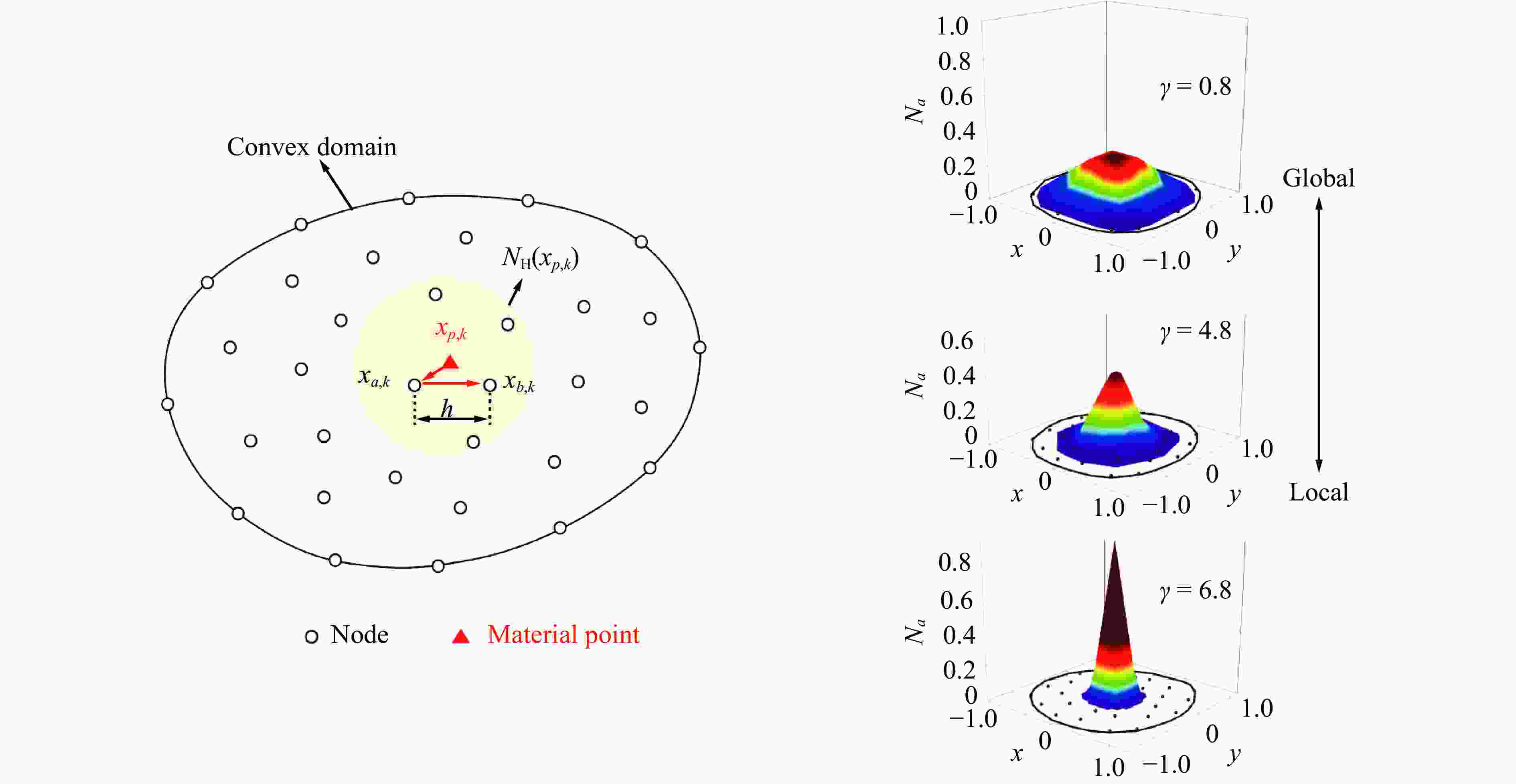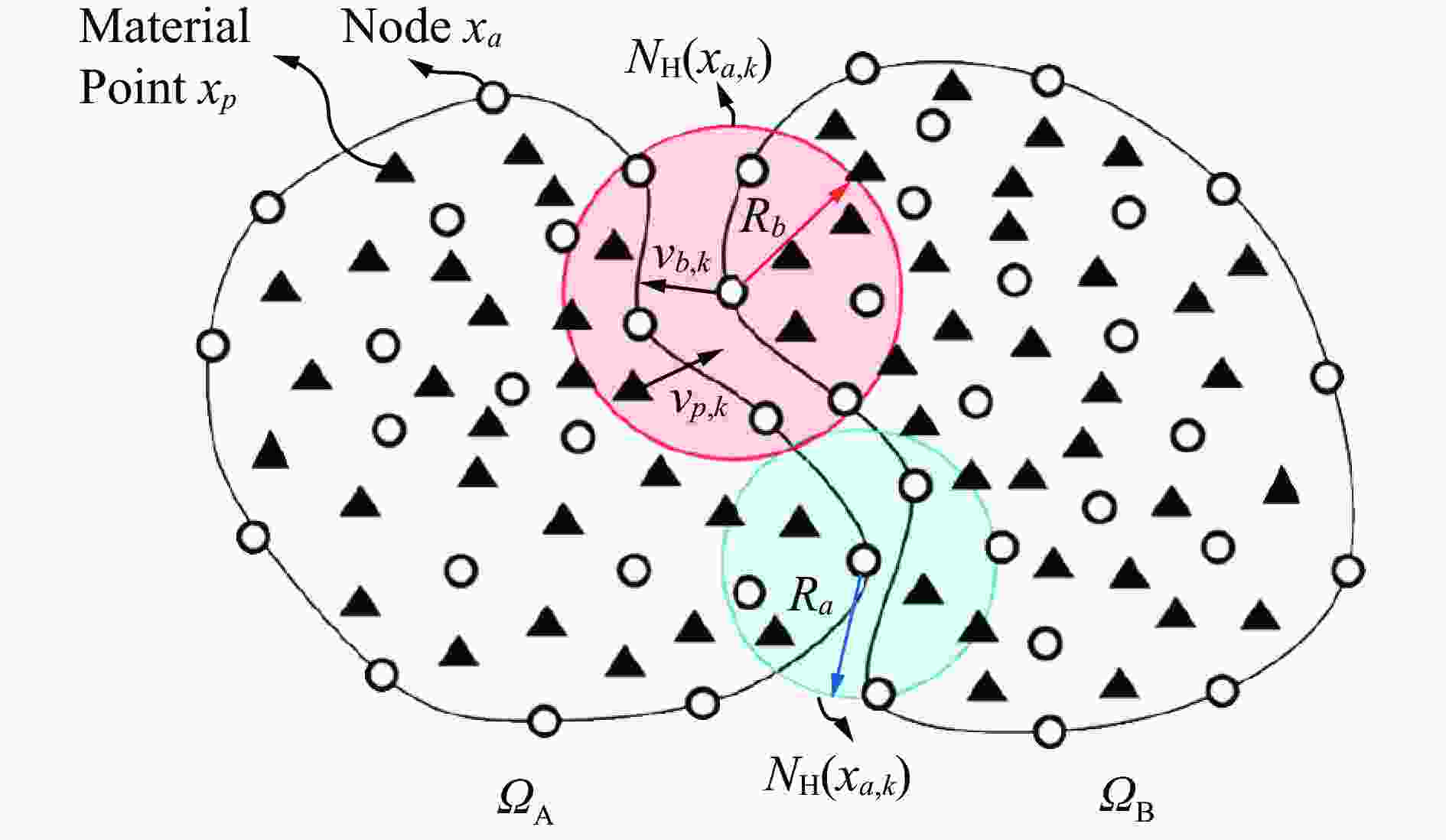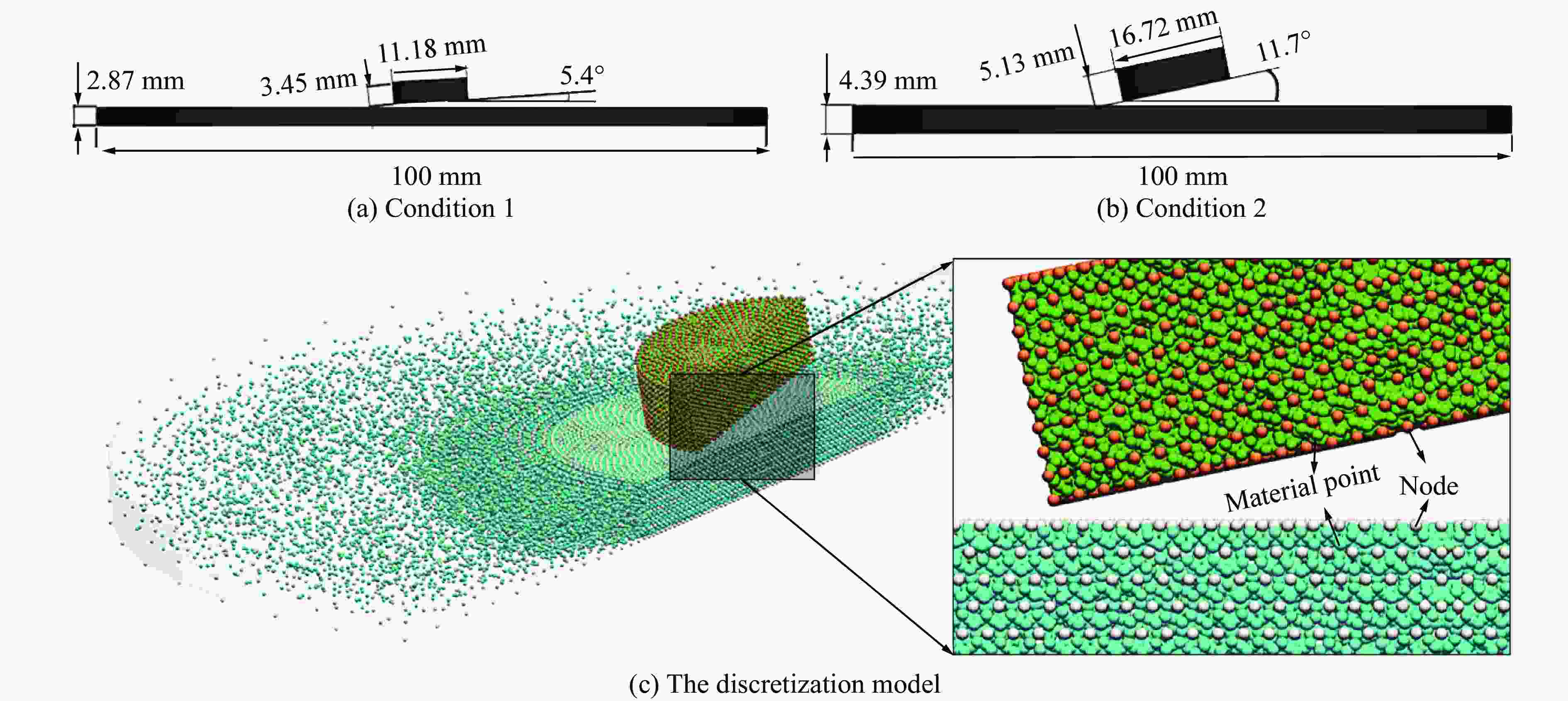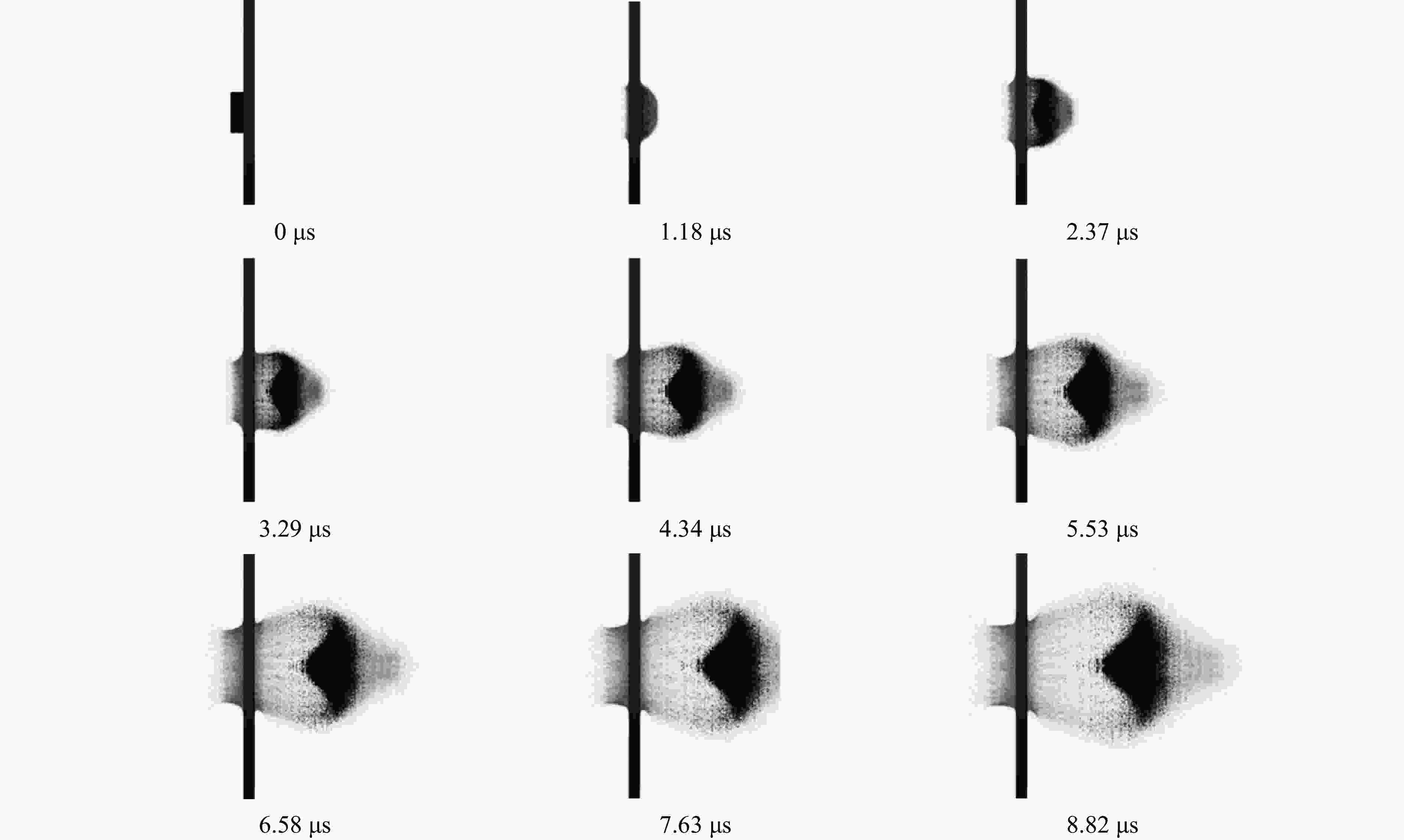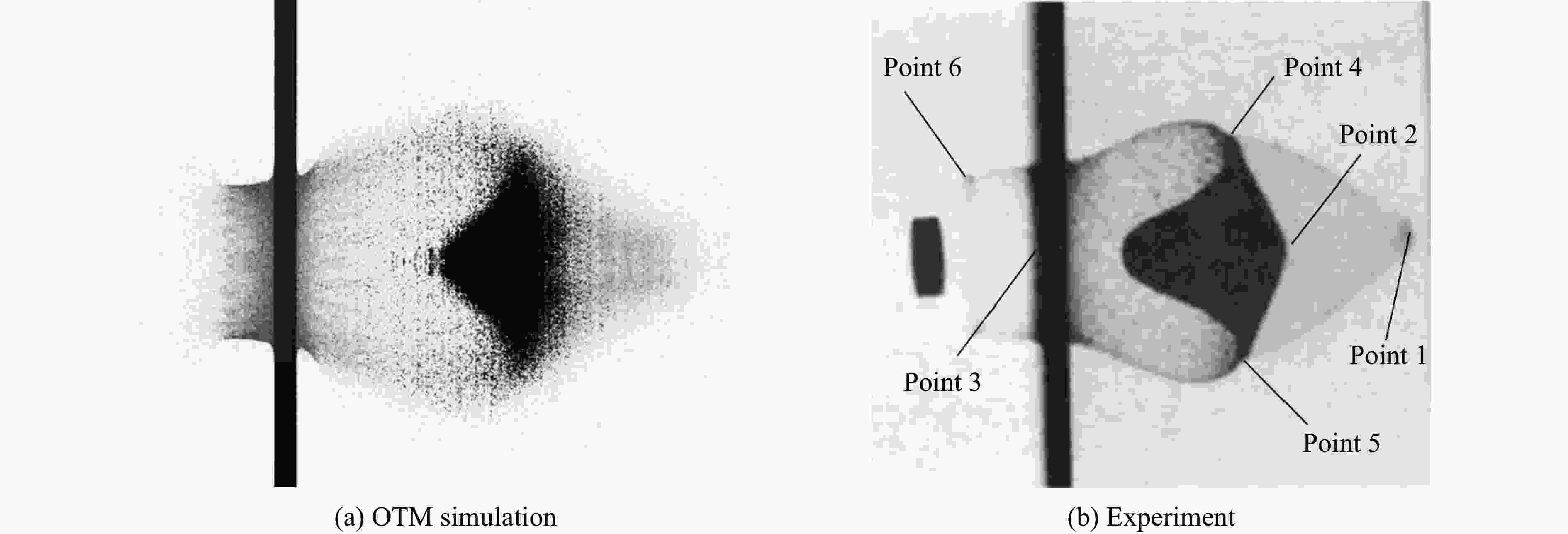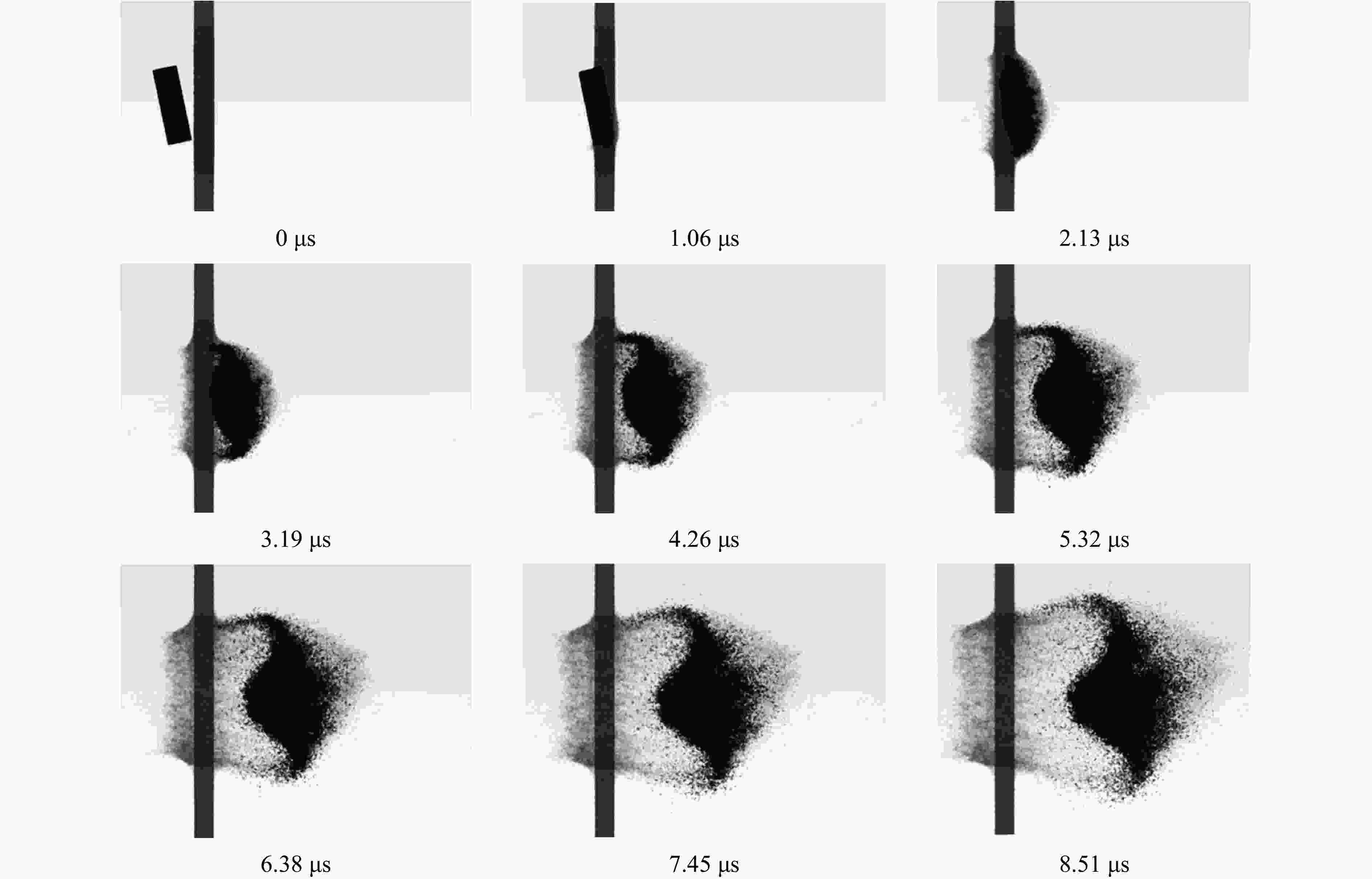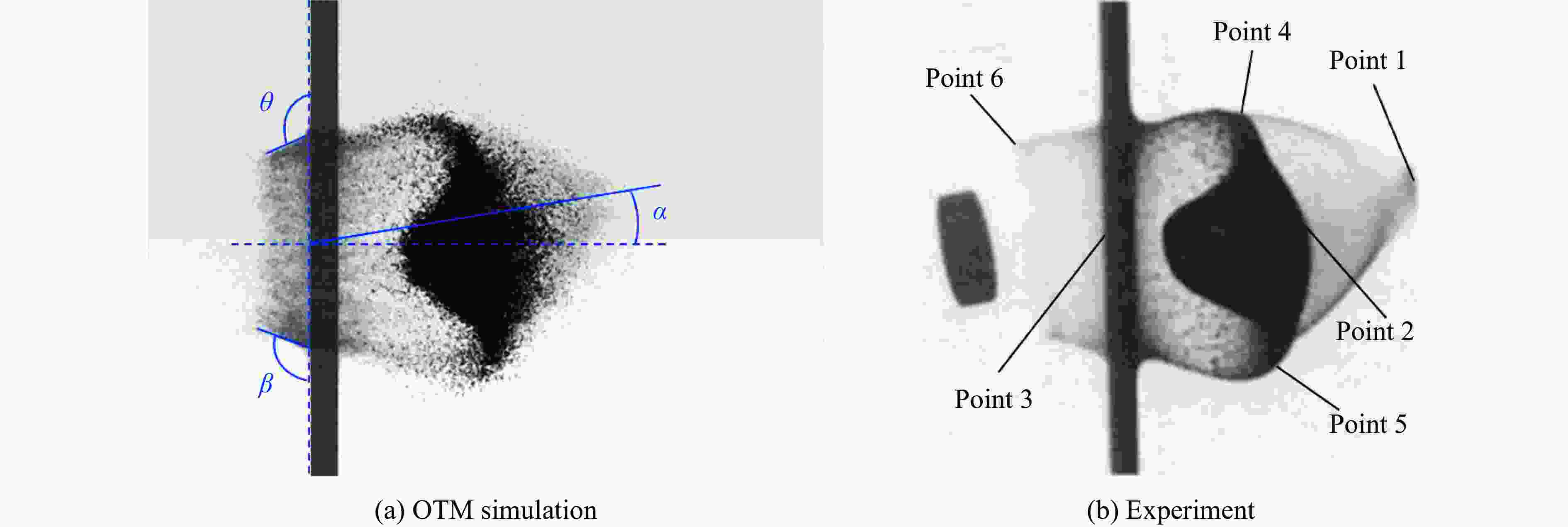OTM analysis of debris cloud under hypervelocity impact
-
摘要: 空间碎片超高速撞击是典型的高温、高压、高应变率的极限力学问题,涉及材料复杂的动态响应,对传统的数值方法提出了巨大挑战。最优运输无网格(OTM)方法通过有机结合最优运输时间积分理论、局部最大熵无网格近似、物质点抽样、基于物理的裂纹扩展算法以及大规模并行计算策略,克服了传统数值方法瓶颈,在理论上保证了不同形式能量耗散的自主耦合分配,为超高速撞击仿真预测提供了高效的解决方案。采用基于OTM方法自主研发的极限力学仿真软件ESCAAS,对不同质量(3、10 g)的铜飞片以不同撞击角度(5.4°、11.7°)和不同撞击速度(5.55、5.12 km/s)撞击铝合金靶板的过程进行数值模拟,获得碎片云的形貌、靶板穿孔孔径等结果,与实验测量数据吻合良好,显示出OTM方法及ESCAAS软件可以作为超高速撞击的有力数值分析手段。Abstract: The hypervelocity impact (HVI) of space debris is a typical extreme mechanics problem at high temperature, high pressure and high strain rate. The HVI involves the complex dynamic response of materials. Numerical methods have become very useful and important tools to predict the complex phenomena and look into the details of the entire process. However, the accurate simulation of the HVI is a grand challenge in scientific computing that places exacting demands on physics models, numerical solvers and computing resources. The optimal transportation meshfree (OTM) method is a meshfree updated-Lagrangian methodology for fluid and solid dynamic flows, possibly involving multiple phases, viscosity and general equations of state, general inelastic and history-dependent constitutive relations, arbitrary variable domains and boundary conditions and the interaction between fluid flows and highly deformable structures. The rationale behind the approach is combining concepts from the optimal transportation (OT) theory with material-point sampling, local maximum entropy (LME) approximation, the seizing contact, variational material point failure algorithm, and overcomes the essential difficulties in grid-based numerical methods like Lagrangian and Eulerian finite element method. Owing to those advantages, the OTM method provides an efficient and accurate solution for HVI simulation. In this paper, large scale three-dimensional numerical simulations on the HVI of the copper projectiles with different thicknesses (3.45, 5.13 mm), different masses (3, 10 g), different impact angles (5.4°, 11.7°) and different impact velocities (5.55, 5.12 km/s) impacting the Al6061-T6 plate with different thicknesses (2.87, 4.39 mm) were performed within the software ESCAAS based on the OTM method using a dynamic load balancing MPI/Pthreads parallel implementation. The dynamic response of material including phase transition in the high strain rate, high pressure and high temperature regime expected in this paper was described by the use of a variational thermomechanical coupling constitutive model with the SESAME equation of state, Grüneisen equation of state, rate-dependent J2 plasticity with power law hardening and thermal softening. The simulation results are in good agreement with the experimental measurements, which indicates the capacity of the OTM method and the ESCAAS software for HVI simulation.
-
Key words:
- hypervelocity impact /
- OTM method /
- crack propagation /
- meshfree
-
表 1 材料物性参数
Table 1. Material parameters
材料 密度/
(kg·m−3)杨氏模量/
GPa泊松比 临界能量释放率/
(kJ·m−2)OFHC铜 8930.0 129.0 0.35 250.0 Al6061-T6铝合金 2700.0 68.9 0.33 100.0 表 2 材料本构模型参数
Table 2. Parameters of material constitutive model
材料 σ0/MPa $ {\varepsilon }_{0}^{\mathrm{p}} $ $ {\dot{\varepsilon }}_{0}^{\mathrm{p}} $ n m l Tm/K OFHC铜 120.0 0.0278 1.0 0.45 1.0 1.0 1790.0 Al6061-T6铝合金 270.0 0.0025 1.0 0.148 0.01389 1.0 1200.0 -
[1] 刘岩, 张雄, 刘平, 等. 空间碎片防护问题的物质点无网格法与软件系统 [J]. 载人航天, 2015, 21(5): 503–509. DOI: 10.16329/j.cnki.zrht.2015.05.013.LIU Y, ZHANG X, LIU P, et al. Meshfree material point method and software system for problems of shielding space debris [J]. Manned Spaceflight, 2015, 21(5): 503–509. DOI: 10.16329/j.cnki.zrht.2015.05.013. [2] DONEA J, GIULIANI S, HALLEUX J P. An arbitrary Lagrangian-Eulerian finite element method for transient dynamic fluid-structure interactions [J]. Computer Methods in Applied Mechanics and Engineering, 1982, 33(1): 689–723. DOI: 10.1016/0045-7825(82)90128-1. [3] DONEA J, HUERTA A, PONTHOT J P, et al. Arbitrary Lagrangian-Eulerian methods [M]//STEIN E, DE BORST R, HUGHES T J R. Encyclopedia of Computational Mechanics. John Wiley, 2004: 413–437. DOI: 10.1002/0470091355.ecm009. [4] QUAN X, BIRNBAUM N K, COWLER M S, et al. Numerical simulation of structural deformation under shock and impact loads using a coupled multi-solver approach [C]// 5th Asia-Pacific Conference on Shock and Impact Loads on Structures. Hunan, 2003. [5] GINGOLD R A, MONAGHAN J J. Smoothed particle hydrodynamics: theory and application to non-spherical stars [J]. Monthly Notices of the Royal Astronomical Society, 1997, 181(3): 375–389. DOI: 10.1093/mnras/181.3.375. [6] LIU W K, JUN S, ZHANG Y F. Reproducing kernel particle methods [J]. International Journal for Numerical Methods in Fluids, 1995, 20(8/9): 1081–1106. DOI: 10.1002/fld.1650200824. [7] ZHANG X, CHEN Z, LIU Y. The material point method [M]//ZHANG X, CHEN Z, LIU Y. The Material Point Method: A Continuum-Based Particle Method for Extreme Loading Cases. Oxford: Academic Press, 2017: 37-101. DOI: 10.1016/B978-0-12-407716-4.00003-X. [8] 闫晓军, 张玉珠, 聂景旭. 空间碎片超高速碰撞数值模拟的SPH方法 [J]. 北京航空航天大学学报, 2005, 31(3): 351–354. DOI: 10.3969/j.issn.1001-5965.2005.03.019.YAN X J, ZHANG Y Z, NIE J X. Numerical simulation of space debris hypervelocity impact using SPH method [J]. Journal of Beijing University of Aeronautics and Astronautics, 2005, 31(3): 351–354. DOI: 10.3969/j.issn.1001-5965.2005.03.019. [9] 刘有英, 王海福. 高速碰撞下航天器防护结构效能评价 [J]. 弹箭与制导学报, 2005, 25(4): 359–361. DOI: 10.3969/j.issn.1673-9728.2005.04.117.LIU Y Y, WANG H F. Evaluations of high-velocity impact for spacecraft shields [J]. Journal of Projectiles, Rockets, Missiles and Guidance, 2005, 25(4): 359–361. DOI: 10.3969/j.issn.1673-9728.2005.04.117. [10] 强洪夫, 范树佳, 陈福振, 等. 基于拟流体模型的SPH新方法及其在弹丸超高速碰撞薄板中的应用 [J]. 爆炸与冲击, 2017, 37(6): 990–1000. DOI: 10.11883/1001-1455(2017)06-0990-11.QIANG H F, FAN S J, CHEN F Z, et al. A new smoothed particle hydrodynamics method based on the pseudo-fluid model and its application in hypervelocity impact of a projectile on a thin plate [J]. Explosion and Shock Waves, 2017, 37(6): 990–1000. DOI: 10.11883/1001-1455(2017)06-0990-11. [11] 林健宇, 罗斌强, 徐名扬, 等. 铝弹丸超高速撞击防护结构的研究进展 [J]. 高压物理学报, 2019, 33(3): 030112. DOI: 10.11858/gywlxb.20190774.LIN J Y, LUO B Q, XU M Y, et al. Progress of aluminum projectile impacting on plate with hypervelocity [J]. Chinese Journal of High Pressure Physics, 2019, 33(3): 030112. DOI: 10.11858/gywlxb.20190774. [12] LI B, HABBAL F, ORTIZ M, et al. Optimal transportation meshfree approximation schemes for fluid and plastic flows [J]. International Journal for Numerical Methods in Engineering, 2010, 83(12): 1541–1579. DOI: 10.1002/nme.2869. [13] ARROYO M, ORTIZ M. Local maximum-entropy approximation schemes: a seamless bridge between finite elements and meshfree methods [J]. International Journal for Numerical Methods in Engineering, 2006, 65(13): 2167–2202. DOI: 10.1002/nme.1534. [14] SANTAMBROGIO F. Introduction to optimal transport theory [EB/OL]. arXiv: 1009.3856. (2010-09-20)[2021-07-01]. https://doi.org/10.48550/arXiv.1009.3856. [15] LI B, STALZER M, ORTIZ M. A massively parallel implementation of the optimal transportation meshfree method for explicit solid dynamics [J]. International Journal for Numerical Methods in Engineering, 2014, 100(1): 40–61. DOI: 10.1002/nme.4710. [16] SCHMIDT B, FRATERNALI F, ORTIZ M. Eigenfracture: an eigendeformation approach to variational fracture [J]. Multiscale Modeling & Simulation, 2009, 7(3): 1237–1266. DOI: 10.1137/080712568. [17] LI B, PANDOLFI A, ORTIZ M. Material-point erosion simulation of dynamic fragmentation of metals [J]. Mechanics of Materials, 2015, 80: 288–297. DOI: 10.1016/j.mechmat.2014.03.008. [18] PANDOLFI A, LI B, ORTIZ M. Modeling fracture by material-point erosion [J]. International Journal of Fracture, 2013, 184(1/2): 3–16. DOI: 10.1007/s10704-012-9788-x. [19] 樊江, 袁圆, 廖祜明, 等. 基于最优运输无网格法的Whipple屏超高速撞击数值模拟 [J]. 爆炸与冲击, 2019, 40(7): 074201. DOI: 10.11883/bzycj-2019-0241.FAN J, YUAN Y, LIAO H M, et al. Numerical simulation of Whipple shield hypervelocity impact based on optimal transportation meshfree method [J]. Explosion and Shock Waves, 2019, 40(7): 074201. DOI: 10.11883/bzycj-2019-0241. [20] STAINIER L. A variational approach to modeling coupled thermo-mechanical nonlinear dissipative behaviors [J]. Advances in Applied Mechanics, 2013, 46: 69–126. DOI: 10.1016/B978-0-12-396522-6.00002-5. [21] 廖祜明. 整体拉格日无网格流固耦合计算方法 [D]. 北京: 北京航空航天大学, 2018: 33–34. [22] FAN J, LIAO H M, WANG H, et al. Local maximum-entropy based surrogate model and its application to structural reliability analysis [J]. Structural and Multidisciplinary Optimization, 2018, 57(1): 373–392. DOI: 10.1007/s00158-017-1760-y. [23] FAN Z Y, WANG H, HUANG Z D, et al. A Lagrangian meshfree mesoscale simulation of powder bed fusion additive manufacturing of metals [J]. International Journal for Numerical Methods in Engineering, 2021, 122(2): 483–514. DOI: 10.1002/nme.6546. [24] NAVAS P, YU R C, LI B, et al. Modeling the dynamic fracture in concrete: an eigensoftening meshfree approach [J]. International Journal of Impact Engineering, 2018, 113: 9–20. DOI: 10.1016/j.ijimpeng.2017.11.004. [25] PIEKUTOWSKI A J. A simple dynamic model for the formation of debris clouds [J]. International Journal of Impact Engineering, 1990, 10(1): 453–471. DOI: 10.1016/0734-743X(90)90079-B. [26] STEINBERG D J. Equation of state and strength properties of selected materials [M]. Livermore: Lawrence Livermore National Laboratory, 1996. -






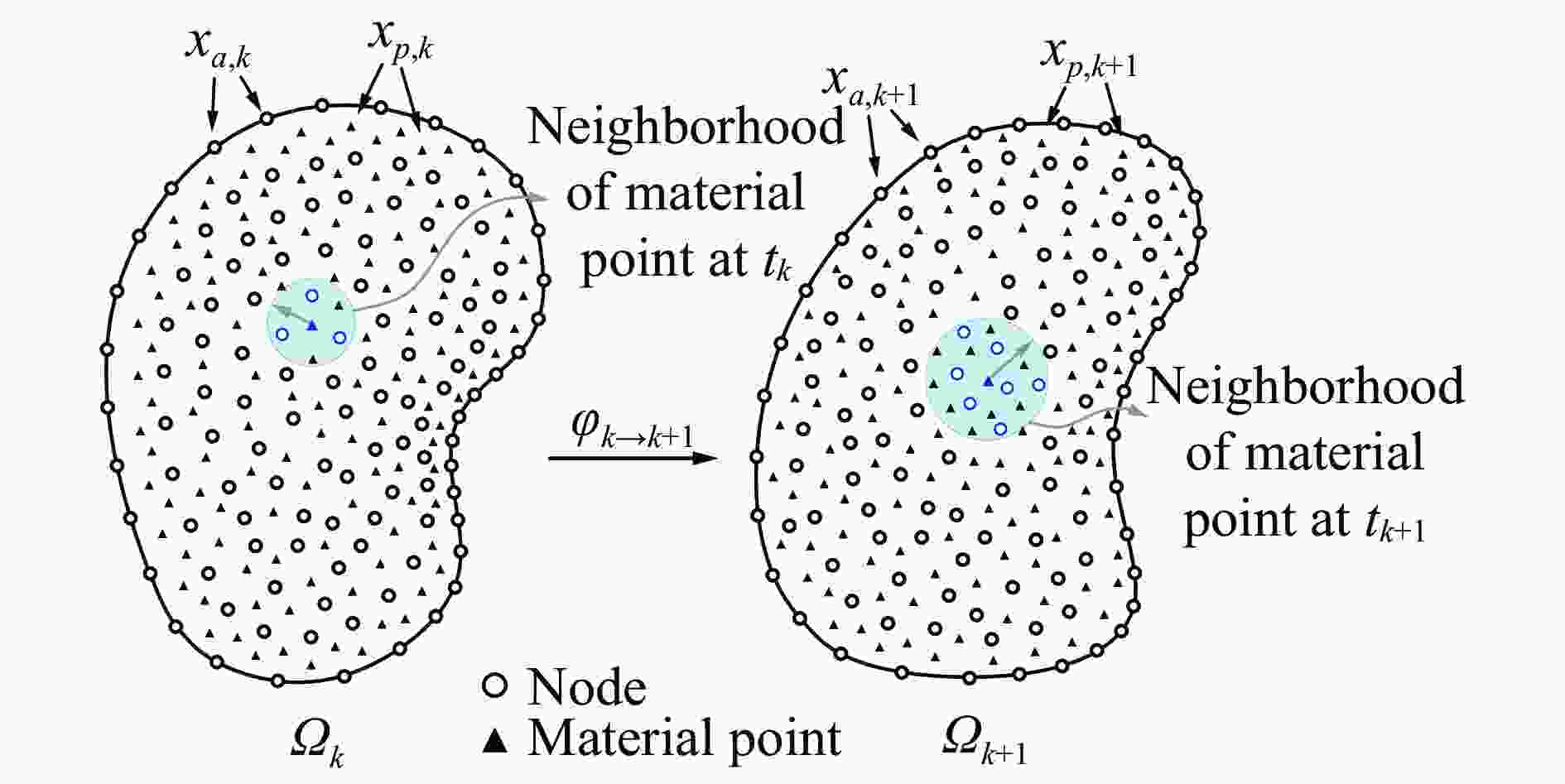
 下载:
下载:
